Qualitative Research: Innovation's Role in Smart City Development
VerifiedAdded on 2020/03/02
|9
|3067
|37
Essay
AI Summary
This qualitative research essay delves into the significance of innovation in the context of Dubai's smart city development. It examines the role of government services in enhancing infrastructure and architecture, with a specific focus on the UAE's initiatives, particularly the declaration of 2015 as the most innovative year. The research employs both primary and secondary sources, including surveys of government entities and staff, to assess strategic plans, technological integration, and the overall impact on the city. The study highlights how innovation is adopted to drive economic growth and improve the quality of life, emphasizing the importance of smart solutions and technological advancements in creating a connected and efficient urban environment. The essay also reviews the evolution of the smart city concept and its various definitions, focusing on the integration of technology and the internet to facilitate transformation, improve citizen services, and enhance the overall growth of the city. The essay concludes by emphasizing the significance of government leadership, citizen-centric e-government, and the use of smart technologies in contributing to the development of Dubai as a global smart city.
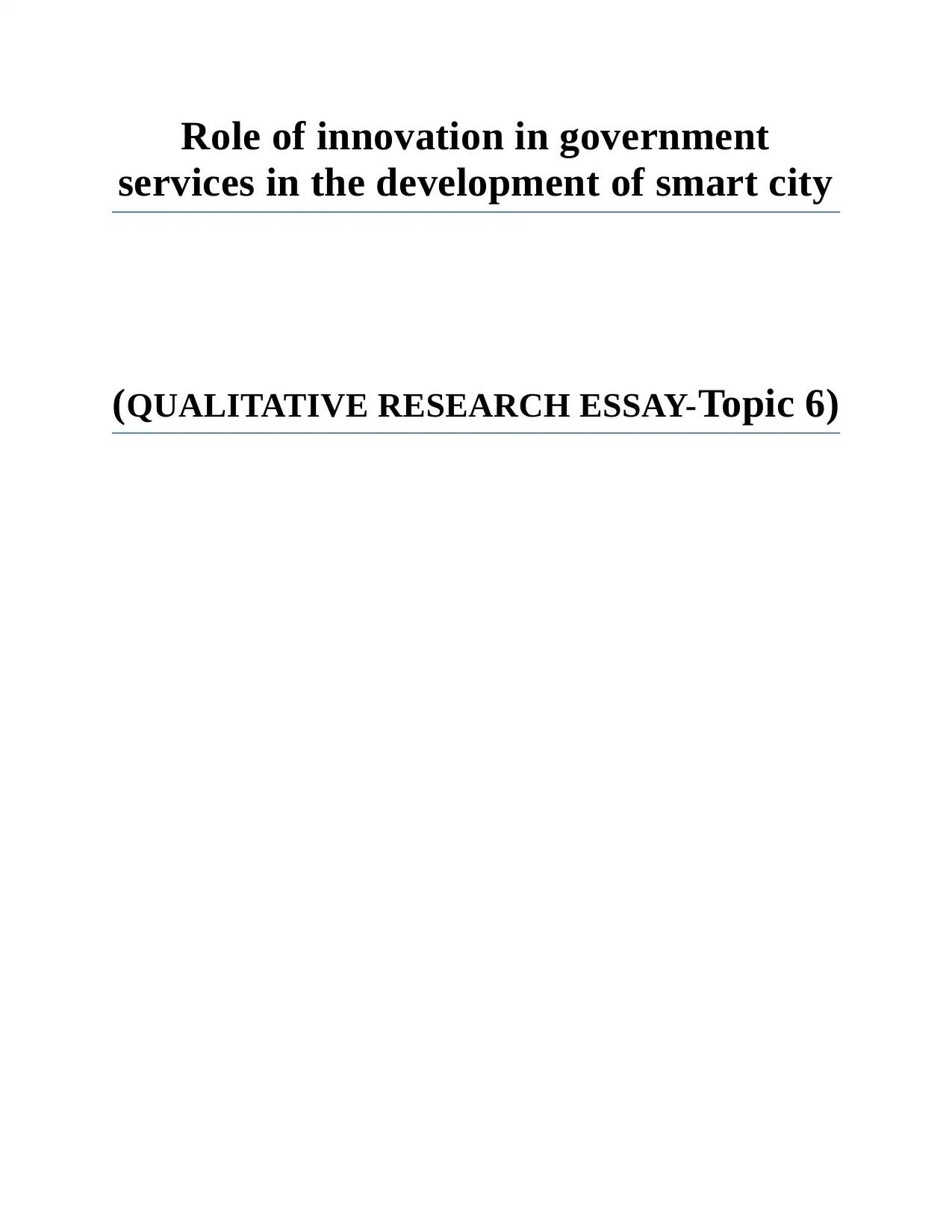
Role of innovation in government
services in the development of smart city
(QUALITATIVE RESEARCH ESSAY-Topic 6)
services in the development of smart city
(QUALITATIVE RESEARCH ESSAY-Topic 6)
Paraphrase This Document
Need a fresh take? Get an instant paraphrase of this document with our AI Paraphraser
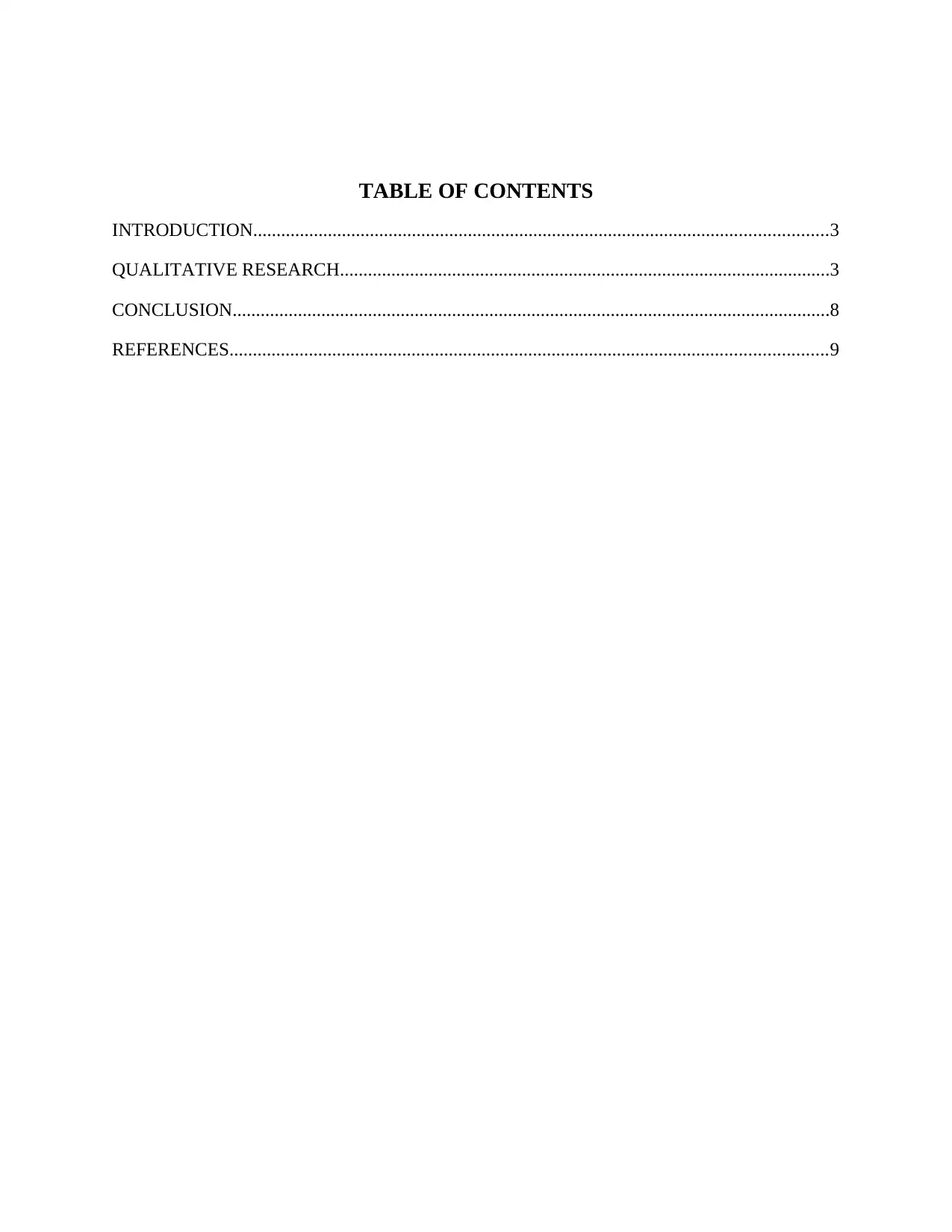
TABLE OF CONTENTS
INTRODUCTION...........................................................................................................................3
QUALITATIVE RESEARCH.........................................................................................................3
CONCLUSION................................................................................................................................8
REFERENCES................................................................................................................................9
INTRODUCTION...........................................................................................................................3
QUALITATIVE RESEARCH.........................................................................................................3
CONCLUSION................................................................................................................................8
REFERENCES................................................................................................................................9
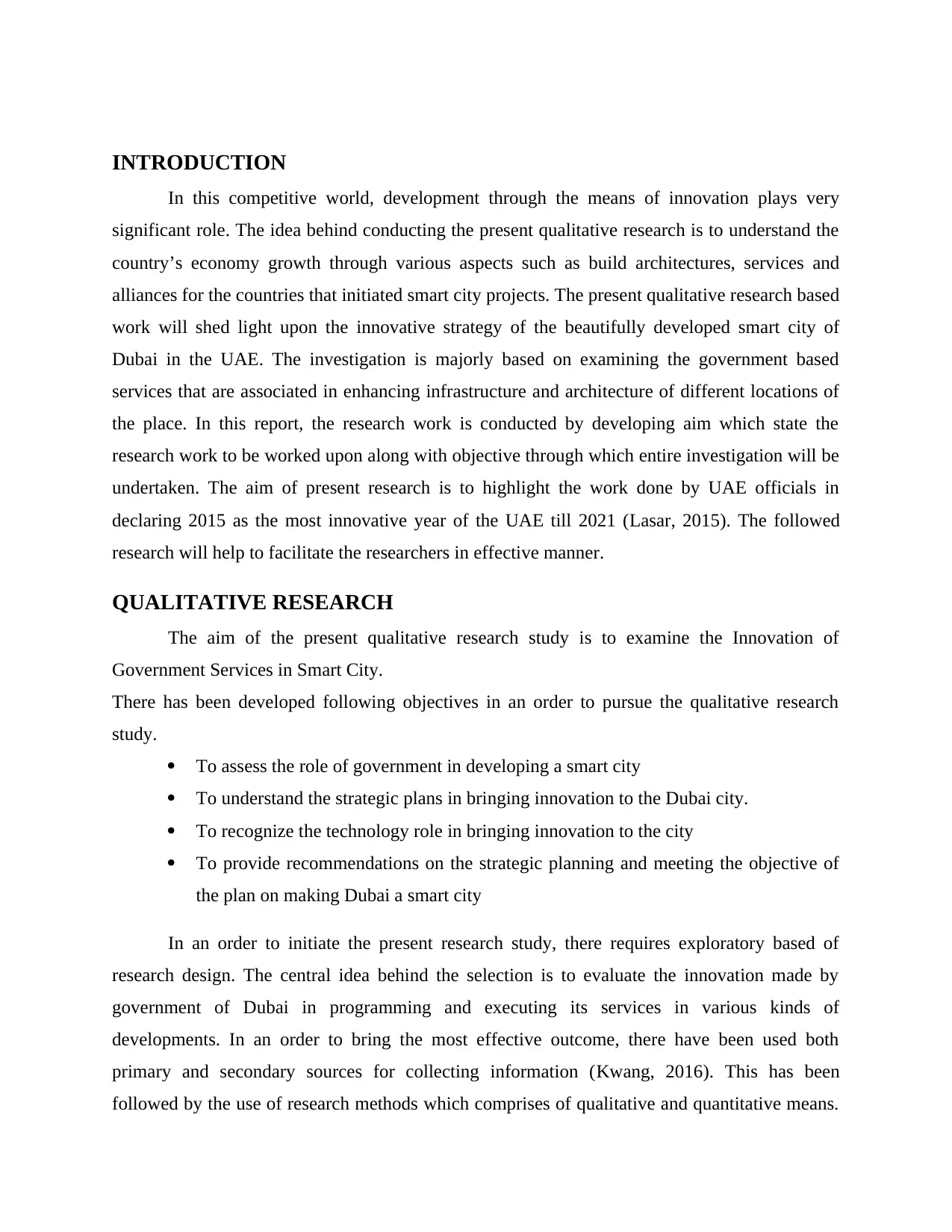
INTRODUCTION
In this competitive world, development through the means of innovation plays very
significant role. The idea behind conducting the present qualitative research is to understand the
country’s economy growth through various aspects such as build architectures, services and
alliances for the countries that initiated smart city projects. The present qualitative research based
work will shed light upon the innovative strategy of the beautifully developed smart city of
Dubai in the UAE. The investigation is majorly based on examining the government based
services that are associated in enhancing infrastructure and architecture of different locations of
the place. In this report, the research work is conducted by developing aim which state the
research work to be worked upon along with objective through which entire investigation will be
undertaken. The aim of present research is to highlight the work done by UAE officials in
declaring 2015 as the most innovative year of the UAE till 2021 (Lasar, 2015). The followed
research will help to facilitate the researchers in effective manner.
QUALITATIVE RESEARCH
The aim of the present qualitative research study is to examine the Innovation of
Government Services in Smart City.
There has been developed following objectives in an order to pursue the qualitative research
study.
To assess the role of government in developing a smart city
To understand the strategic plans in bringing innovation to the Dubai city.
To recognize the technology role in bringing innovation to the city
To provide recommendations on the strategic planning and meeting the objective of
the plan on making Dubai a smart city
In an order to initiate the present research study, there requires exploratory based of
research design. The central idea behind the selection is to evaluate the innovation made by
government of Dubai in programming and executing its services in various kinds of
developments. In an order to bring the most effective outcome, there have been used both
primary and secondary sources for collecting information (Kwang, 2016). This has been
followed by the use of research methods which comprises of qualitative and quantitative means.
In this competitive world, development through the means of innovation plays very
significant role. The idea behind conducting the present qualitative research is to understand the
country’s economy growth through various aspects such as build architectures, services and
alliances for the countries that initiated smart city projects. The present qualitative research based
work will shed light upon the innovative strategy of the beautifully developed smart city of
Dubai in the UAE. The investigation is majorly based on examining the government based
services that are associated in enhancing infrastructure and architecture of different locations of
the place. In this report, the research work is conducted by developing aim which state the
research work to be worked upon along with objective through which entire investigation will be
undertaken. The aim of present research is to highlight the work done by UAE officials in
declaring 2015 as the most innovative year of the UAE till 2021 (Lasar, 2015). The followed
research will help to facilitate the researchers in effective manner.
QUALITATIVE RESEARCH
The aim of the present qualitative research study is to examine the Innovation of
Government Services in Smart City.
There has been developed following objectives in an order to pursue the qualitative research
study.
To assess the role of government in developing a smart city
To understand the strategic plans in bringing innovation to the Dubai city.
To recognize the technology role in bringing innovation to the city
To provide recommendations on the strategic planning and meeting the objective of
the plan on making Dubai a smart city
In an order to initiate the present research study, there requires exploratory based of
research design. The central idea behind the selection is to evaluate the innovation made by
government of Dubai in programming and executing its services in various kinds of
developments. In an order to bring the most effective outcome, there have been used both
primary and secondary sources for collecting information (Kwang, 2016). This has been
followed by the use of research methods which comprises of qualitative and quantitative means.
⊘ This is a preview!⊘
Do you want full access?
Subscribe today to unlock all pages.

Trusted by 1+ million students worldwide
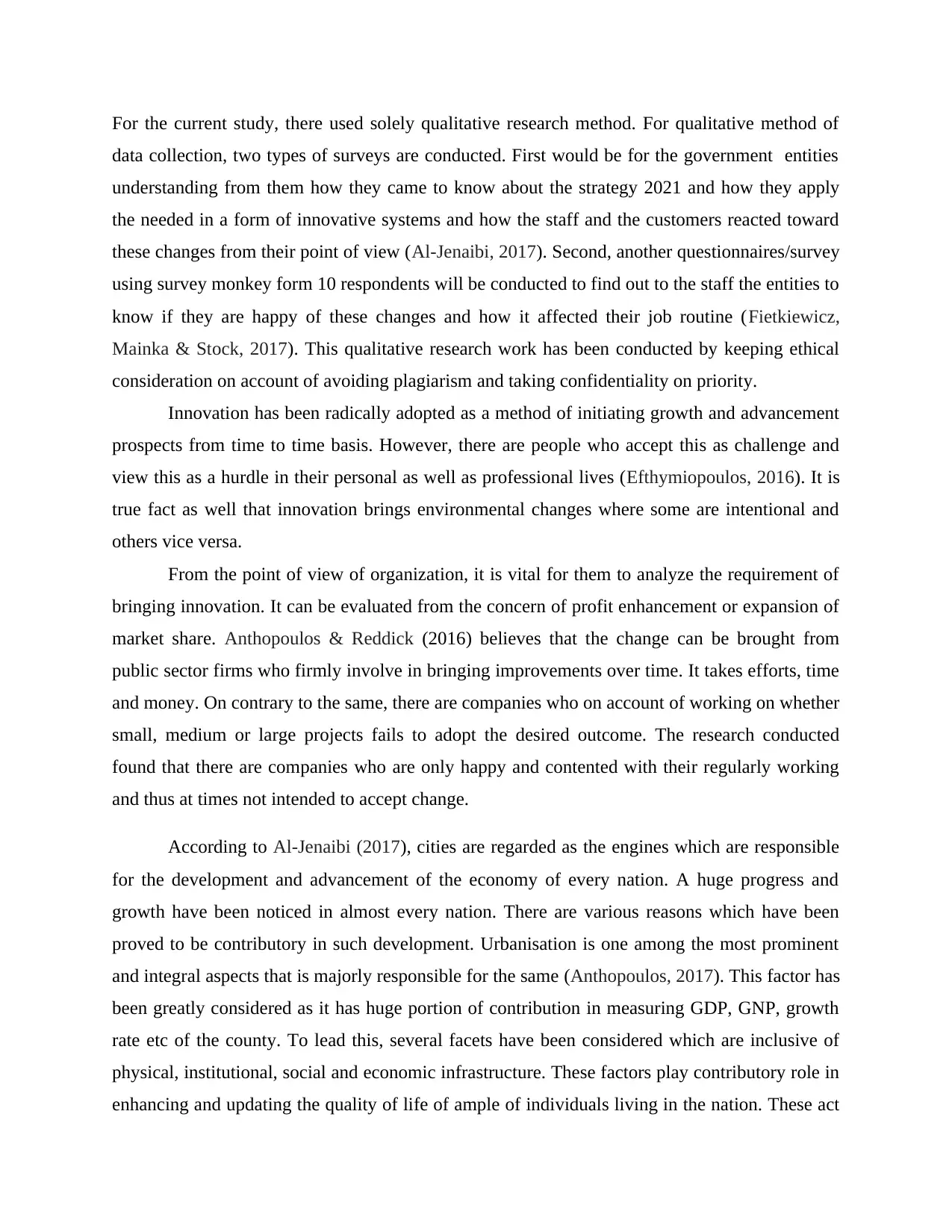
For the current study, there used solely qualitative research method. For qualitative method of
data collection, two types of surveys are conducted. First would be for the government entities
understanding from them how they came to know about the strategy 2021 and how they apply
the needed in a form of innovative systems and how the staff and the customers reacted toward
these changes from their point of view (Al-Jenaibi, 2017). Second, another questionnaires/survey
using survey monkey form 10 respondents will be conducted to find out to the staff the entities to
know if they are happy of these changes and how it affected their job routine (Fietkiewicz,
Mainka & Stock, 2017). This qualitative research work has been conducted by keeping ethical
consideration on account of avoiding plagiarism and taking confidentiality on priority.
Innovation has been radically adopted as a method of initiating growth and advancement
prospects from time to time basis. However, there are people who accept this as challenge and
view this as a hurdle in their personal as well as professional lives (Efthymiopoulos, 2016). It is
true fact as well that innovation brings environmental changes where some are intentional and
others vice versa.
From the point of view of organization, it is vital for them to analyze the requirement of
bringing innovation. It can be evaluated from the concern of profit enhancement or expansion of
market share. Anthopoulos & Reddick (2016) believes that the change can be brought from
public sector firms who firmly involve in bringing improvements over time. It takes efforts, time
and money. On contrary to the same, there are companies who on account of working on whether
small, medium or large projects fails to adopt the desired outcome. The research conducted
found that there are companies who are only happy and contented with their regularly working
and thus at times not intended to accept change.
According to Al-Jenaibi (2017), cities are regarded as the engines which are responsible
for the development and advancement of the economy of every nation. A huge progress and
growth have been noticed in almost every nation. There are various reasons which have been
proved to be contributory in such development. Urbanisation is one among the most prominent
and integral aspects that is majorly responsible for the same (Anthopoulos, 2017). This factor has
been greatly considered as it has huge portion of contribution in measuring GDP, GNP, growth
rate etc of the county. To lead this, several facets have been considered which are inclusive of
physical, institutional, social and economic infrastructure. These factors play contributory role in
enhancing and updating the quality of life of ample of individuals living in the nation. These act
data collection, two types of surveys are conducted. First would be for the government entities
understanding from them how they came to know about the strategy 2021 and how they apply
the needed in a form of innovative systems and how the staff and the customers reacted toward
these changes from their point of view (Al-Jenaibi, 2017). Second, another questionnaires/survey
using survey monkey form 10 respondents will be conducted to find out to the staff the entities to
know if they are happy of these changes and how it affected their job routine (Fietkiewicz,
Mainka & Stock, 2017). This qualitative research work has been conducted by keeping ethical
consideration on account of avoiding plagiarism and taking confidentiality on priority.
Innovation has been radically adopted as a method of initiating growth and advancement
prospects from time to time basis. However, there are people who accept this as challenge and
view this as a hurdle in their personal as well as professional lives (Efthymiopoulos, 2016). It is
true fact as well that innovation brings environmental changes where some are intentional and
others vice versa.
From the point of view of organization, it is vital for them to analyze the requirement of
bringing innovation. It can be evaluated from the concern of profit enhancement or expansion of
market share. Anthopoulos & Reddick (2016) believes that the change can be brought from
public sector firms who firmly involve in bringing improvements over time. It takes efforts, time
and money. On contrary to the same, there are companies who on account of working on whether
small, medium or large projects fails to adopt the desired outcome. The research conducted
found that there are companies who are only happy and contented with their regularly working
and thus at times not intended to accept change.
According to Al-Jenaibi (2017), cities are regarded as the engines which are responsible
for the development and advancement of the economy of every nation. A huge progress and
growth have been noticed in almost every nation. There are various reasons which have been
proved to be contributory in such development. Urbanisation is one among the most prominent
and integral aspects that is majorly responsible for the same (Anthopoulos, 2017). This factor has
been greatly considered as it has huge portion of contribution in measuring GDP, GNP, growth
rate etc of the county. To lead this, several facets have been considered which are inclusive of
physical, institutional, social and economic infrastructure. These factors play contributory role in
enhancing and updating the quality of life of ample of individuals living in the nation. These act
Paraphrase This Document
Need a fresh take? Get an instant paraphrase of this document with our AI Paraphraser
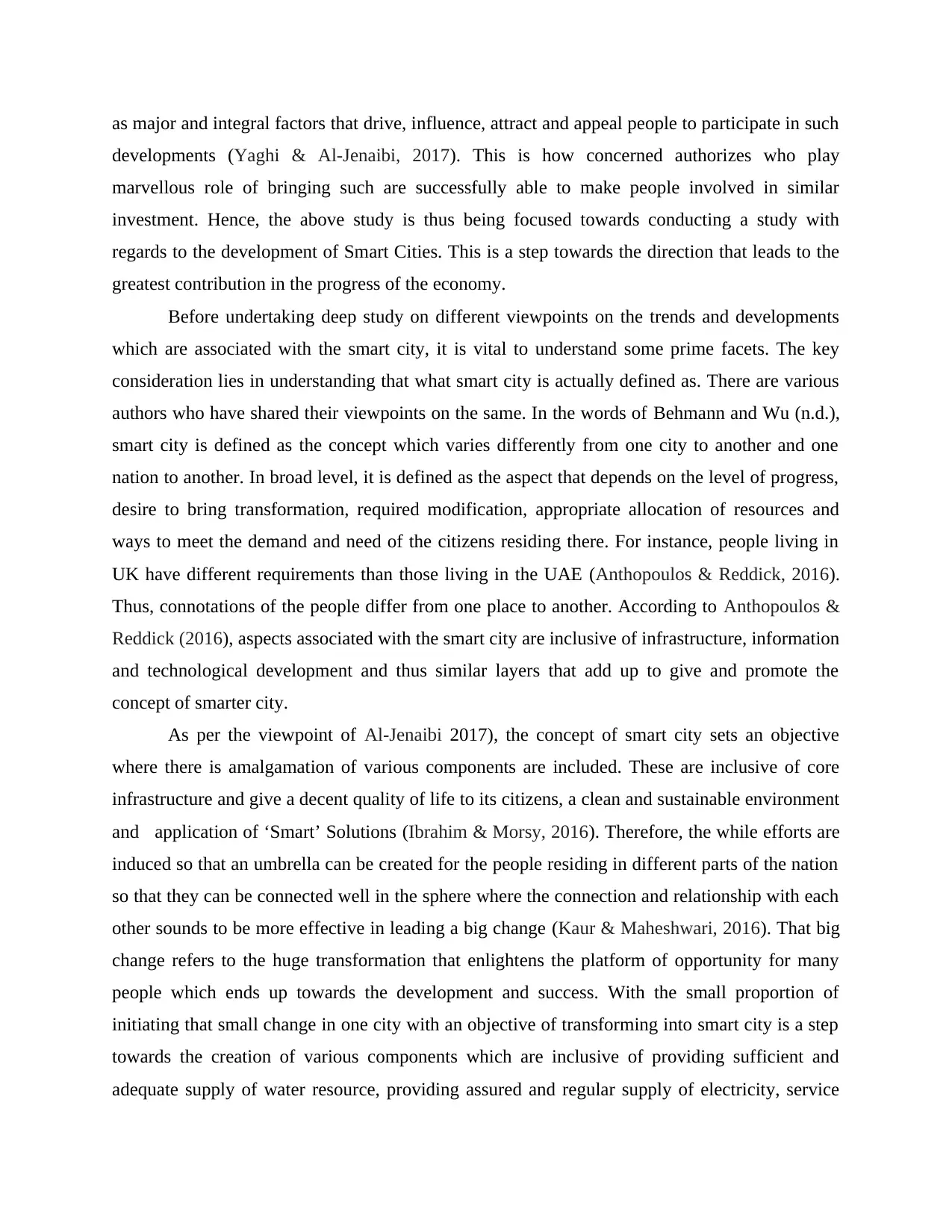
as major and integral factors that drive, influence, attract and appeal people to participate in such
developments (Yaghi & Al-Jenaibi, 2017). This is how concerned authorizes who play
marvellous role of bringing such are successfully able to make people involved in similar
investment. Hence, the above study is thus being focused towards conducting a study with
regards to the development of Smart Cities. This is a step towards the direction that leads to the
greatest contribution in the progress of the economy.
Before undertaking deep study on different viewpoints on the trends and developments
which are associated with the smart city, it is vital to understand some prime facets. The key
consideration lies in understanding that what smart city is actually defined as. There are various
authors who have shared their viewpoints on the same. In the words of Behmann and Wu (n.d.),
smart city is defined as the concept which varies differently from one city to another and one
nation to another. In broad level, it is defined as the aspect that depends on the level of progress,
desire to bring transformation, required modification, appropriate allocation of resources and
ways to meet the demand and need of the citizens residing there. For instance, people living in
UK have different requirements than those living in the UAE (Anthopoulos & Reddick, 2016).
Thus, connotations of the people differ from one place to another. According to Anthopoulos &
Reddick (2016), aspects associated with the smart city are inclusive of infrastructure, information
and technological development and thus similar layers that add up to give and promote the
concept of smarter city.
As per the viewpoint of Al-Jenaibi 2017), the concept of smart city sets an objective
where there is amalgamation of various components are included. These are inclusive of core
infrastructure and give a decent quality of life to its citizens, a clean and sustainable environment
and application of ‘Smart’ Solutions (Ibrahim & Morsy, 2016). Therefore, the while efforts are
induced so that an umbrella can be created for the people residing in different parts of the nation
so that they can be connected well in the sphere where the connection and relationship with each
other sounds to be more effective in leading a big change (Kaur & Maheshwari, 2016). That big
change refers to the huge transformation that enlightens the platform of opportunity for many
people which ends up towards the development and success. With the small proportion of
initiating that small change in one city with an objective of transforming into smart city is a step
towards the creation of various components which are inclusive of providing sufficient and
adequate supply of water resource, providing assured and regular supply of electricity, service
developments (Yaghi & Al-Jenaibi, 2017). This is how concerned authorizes who play
marvellous role of bringing such are successfully able to make people involved in similar
investment. Hence, the above study is thus being focused towards conducting a study with
regards to the development of Smart Cities. This is a step towards the direction that leads to the
greatest contribution in the progress of the economy.
Before undertaking deep study on different viewpoints on the trends and developments
which are associated with the smart city, it is vital to understand some prime facets. The key
consideration lies in understanding that what smart city is actually defined as. There are various
authors who have shared their viewpoints on the same. In the words of Behmann and Wu (n.d.),
smart city is defined as the concept which varies differently from one city to another and one
nation to another. In broad level, it is defined as the aspect that depends on the level of progress,
desire to bring transformation, required modification, appropriate allocation of resources and
ways to meet the demand and need of the citizens residing there. For instance, people living in
UK have different requirements than those living in the UAE (Anthopoulos & Reddick, 2016).
Thus, connotations of the people differ from one place to another. According to Anthopoulos &
Reddick (2016), aspects associated with the smart city are inclusive of infrastructure, information
and technological development and thus similar layers that add up to give and promote the
concept of smarter city.
As per the viewpoint of Al-Jenaibi 2017), the concept of smart city sets an objective
where there is amalgamation of various components are included. These are inclusive of core
infrastructure and give a decent quality of life to its citizens, a clean and sustainable environment
and application of ‘Smart’ Solutions (Ibrahim & Morsy, 2016). Therefore, the while efforts are
induced so that an umbrella can be created for the people residing in different parts of the nation
so that they can be connected well in the sphere where the connection and relationship with each
other sounds to be more effective in leading a big change (Kaur & Maheshwari, 2016). That big
change refers to the huge transformation that enlightens the platform of opportunity for many
people which ends up towards the development and success. With the small proportion of
initiating that small change in one city with an objective of transforming into smart city is a step
towards the creation of various components which are inclusive of providing sufficient and
adequate supply of water resource, providing assured and regular supply of electricity, service
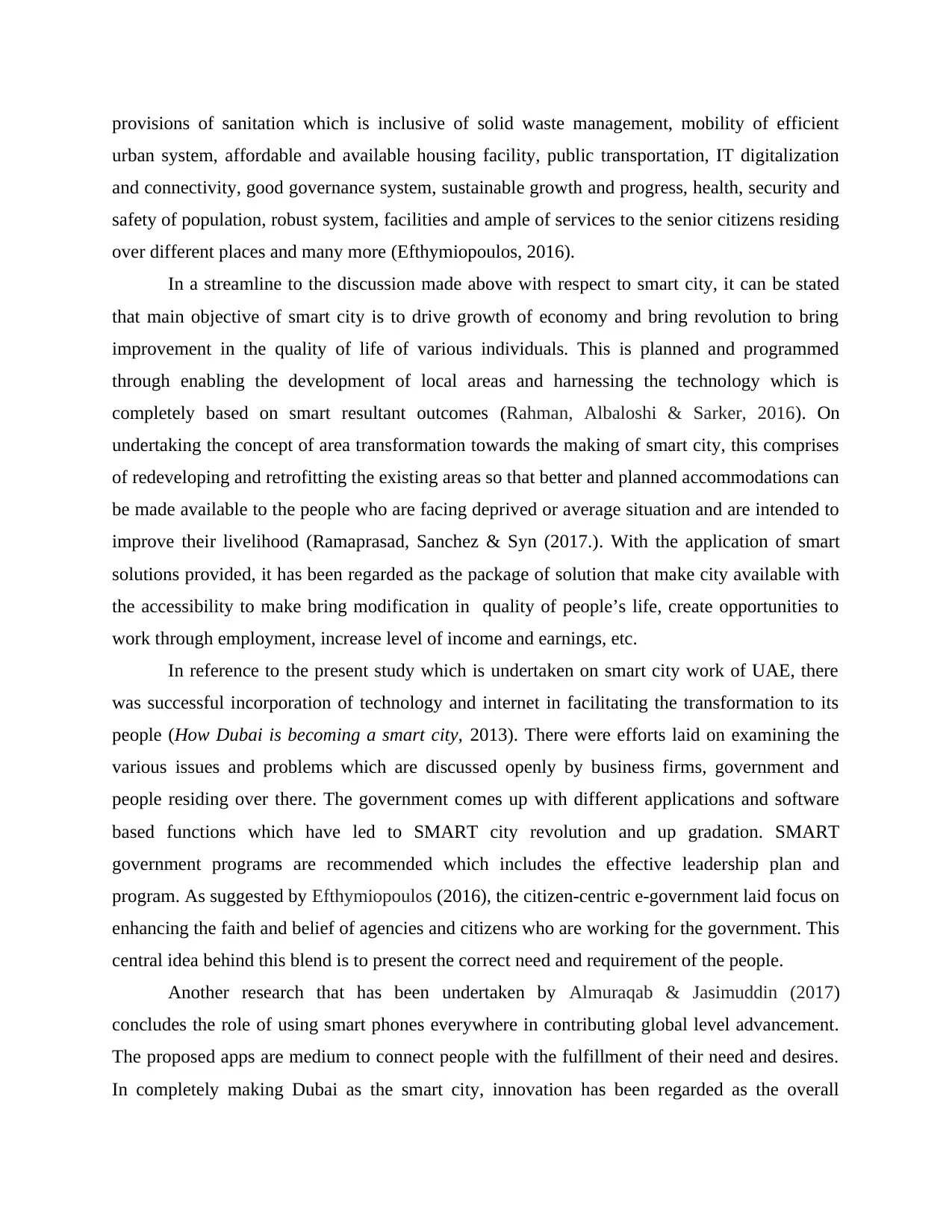
provisions of sanitation which is inclusive of solid waste management, mobility of efficient
urban system, affordable and available housing facility, public transportation, IT digitalization
and connectivity, good governance system, sustainable growth and progress, health, security and
safety of population, robust system, facilities and ample of services to the senior citizens residing
over different places and many more (Efthymiopoulos, 2016).
In a streamline to the discussion made above with respect to smart city, it can be stated
that main objective of smart city is to drive growth of economy and bring revolution to bring
improvement in the quality of life of various individuals. This is planned and programmed
through enabling the development of local areas and harnessing the technology which is
completely based on smart resultant outcomes (Rahman, Albaloshi & Sarker, 2016). On
undertaking the concept of area transformation towards the making of smart city, this comprises
of redeveloping and retrofitting the existing areas so that better and planned accommodations can
be made available to the people who are facing deprived or average situation and are intended to
improve their livelihood (Ramaprasad, Sanchez & Syn (2017.). With the application of smart
solutions provided, it has been regarded as the package of solution that make city available with
the accessibility to make bring modification in quality of people’s life, create opportunities to
work through employment, increase level of income and earnings, etc.
In reference to the present study which is undertaken on smart city work of UAE, there
was successful incorporation of technology and internet in facilitating the transformation to its
people (How Dubai is becoming a smart city, 2013). There were efforts laid on examining the
various issues and problems which are discussed openly by business firms, government and
people residing over there. The government comes up with different applications and software
based functions which have led to SMART city revolution and up gradation. SMART
government programs are recommended which includes the effective leadership plan and
program. As suggested by Efthymiopoulos (2016), the citizen-centric e-government laid focus on
enhancing the faith and belief of agencies and citizens who are working for the government. This
central idea behind this blend is to present the correct need and requirement of the people.
Another research that has been undertaken by Almuraqab & Jasimuddin (2017)
concludes the role of using smart phones everywhere in contributing global level advancement.
The proposed apps are medium to connect people with the fulfillment of their need and desires.
In completely making Dubai as the smart city, innovation has been regarded as the overall
urban system, affordable and available housing facility, public transportation, IT digitalization
and connectivity, good governance system, sustainable growth and progress, health, security and
safety of population, robust system, facilities and ample of services to the senior citizens residing
over different places and many more (Efthymiopoulos, 2016).
In a streamline to the discussion made above with respect to smart city, it can be stated
that main objective of smart city is to drive growth of economy and bring revolution to bring
improvement in the quality of life of various individuals. This is planned and programmed
through enabling the development of local areas and harnessing the technology which is
completely based on smart resultant outcomes (Rahman, Albaloshi & Sarker, 2016). On
undertaking the concept of area transformation towards the making of smart city, this comprises
of redeveloping and retrofitting the existing areas so that better and planned accommodations can
be made available to the people who are facing deprived or average situation and are intended to
improve their livelihood (Ramaprasad, Sanchez & Syn (2017.). With the application of smart
solutions provided, it has been regarded as the package of solution that make city available with
the accessibility to make bring modification in quality of people’s life, create opportunities to
work through employment, increase level of income and earnings, etc.
In reference to the present study which is undertaken on smart city work of UAE, there
was successful incorporation of technology and internet in facilitating the transformation to its
people (How Dubai is becoming a smart city, 2013). There were efforts laid on examining the
various issues and problems which are discussed openly by business firms, government and
people residing over there. The government comes up with different applications and software
based functions which have led to SMART city revolution and up gradation. SMART
government programs are recommended which includes the effective leadership plan and
program. As suggested by Efthymiopoulos (2016), the citizen-centric e-government laid focus on
enhancing the faith and belief of agencies and citizens who are working for the government. This
central idea behind this blend is to present the correct need and requirement of the people.
Another research that has been undertaken by Almuraqab & Jasimuddin (2017)
concludes the role of using smart phones everywhere in contributing global level advancement.
The proposed apps are medium to connect people with the fulfillment of their need and desires.
In completely making Dubai as the smart city, innovation has been regarded as the overall
⊘ This is a preview!⊘
Do you want full access?
Subscribe today to unlock all pages.

Trusted by 1+ million students worldwide
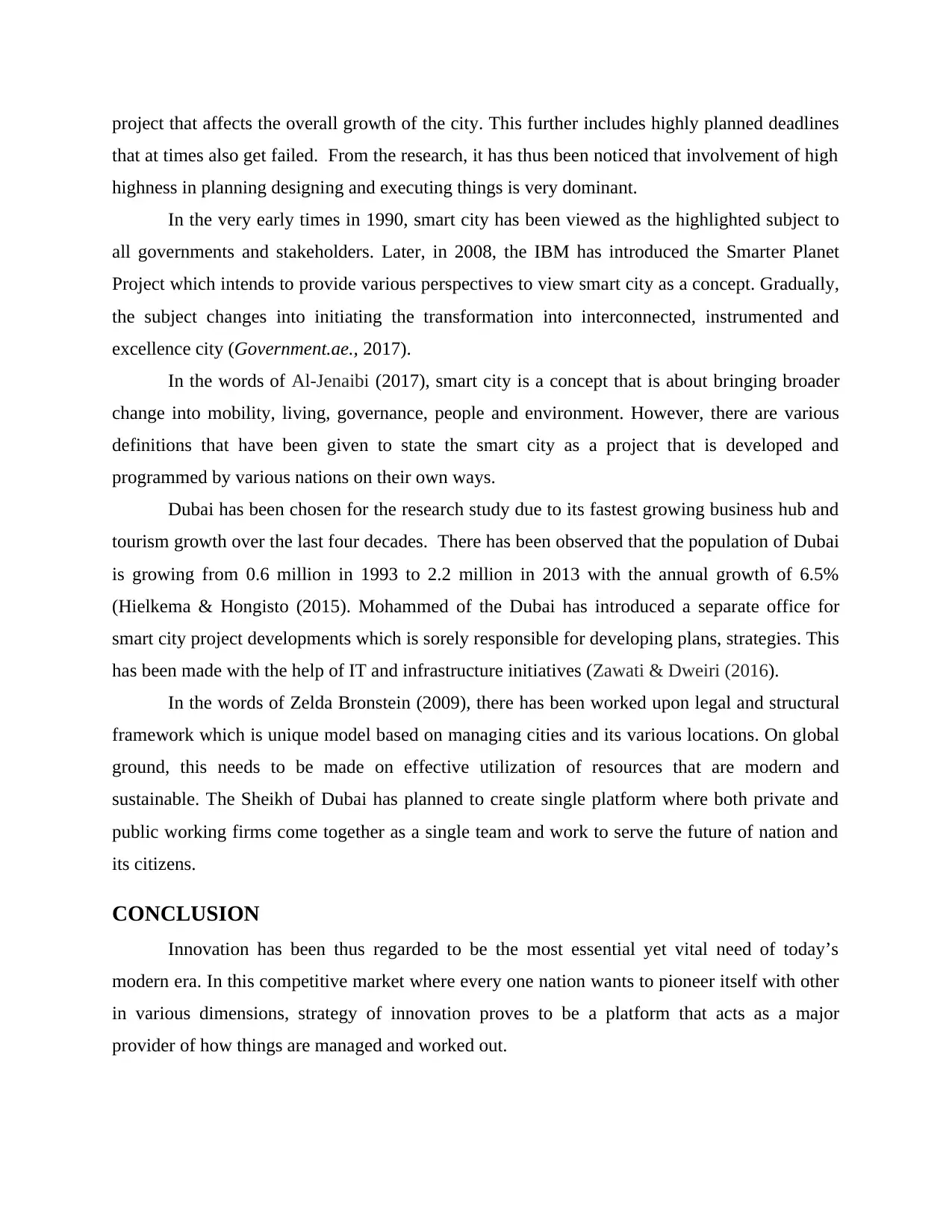
project that affects the overall growth of the city. This further includes highly planned deadlines
that at times also get failed. From the research, it has thus been noticed that involvement of high
highness in planning designing and executing things is very dominant.
In the very early times in 1990, smart city has been viewed as the highlighted subject to
all governments and stakeholders. Later, in 2008, the IBM has introduced the Smarter Planet
Project which intends to provide various perspectives to view smart city as a concept. Gradually,
the subject changes into initiating the transformation into interconnected, instrumented and
excellence city (Government.ae., 2017).
In the words of Al-Jenaibi (2017), smart city is a concept that is about bringing broader
change into mobility, living, governance, people and environment. However, there are various
definitions that have been given to state the smart city as a project that is developed and
programmed by various nations on their own ways.
Dubai has been chosen for the research study due to its fastest growing business hub and
tourism growth over the last four decades. There has been observed that the population of Dubai
is growing from 0.6 million in 1993 to 2.2 million in 2013 with the annual growth of 6.5%
(Hielkema & Hongisto (2015). Mohammed of the Dubai has introduced a separate office for
smart city project developments which is sorely responsible for developing plans, strategies. This
has been made with the help of IT and infrastructure initiatives (Zawati & Dweiri (2016).
In the words of Zelda Bronstein (2009), there has been worked upon legal and structural
framework which is unique model based on managing cities and its various locations. On global
ground, this needs to be made on effective utilization of resources that are modern and
sustainable. The Sheikh of Dubai has planned to create single platform where both private and
public working firms come together as a single team and work to serve the future of nation and
its citizens.
CONCLUSION
Innovation has been thus regarded to be the most essential yet vital need of today’s
modern era. In this competitive market where every one nation wants to pioneer itself with other
in various dimensions, strategy of innovation proves to be a platform that acts as a major
provider of how things are managed and worked out.
that at times also get failed. From the research, it has thus been noticed that involvement of high
highness in planning designing and executing things is very dominant.
In the very early times in 1990, smart city has been viewed as the highlighted subject to
all governments and stakeholders. Later, in 2008, the IBM has introduced the Smarter Planet
Project which intends to provide various perspectives to view smart city as a concept. Gradually,
the subject changes into initiating the transformation into interconnected, instrumented and
excellence city (Government.ae., 2017).
In the words of Al-Jenaibi (2017), smart city is a concept that is about bringing broader
change into mobility, living, governance, people and environment. However, there are various
definitions that have been given to state the smart city as a project that is developed and
programmed by various nations on their own ways.
Dubai has been chosen for the research study due to its fastest growing business hub and
tourism growth over the last four decades. There has been observed that the population of Dubai
is growing from 0.6 million in 1993 to 2.2 million in 2013 with the annual growth of 6.5%
(Hielkema & Hongisto (2015). Mohammed of the Dubai has introduced a separate office for
smart city project developments which is sorely responsible for developing plans, strategies. This
has been made with the help of IT and infrastructure initiatives (Zawati & Dweiri (2016).
In the words of Zelda Bronstein (2009), there has been worked upon legal and structural
framework which is unique model based on managing cities and its various locations. On global
ground, this needs to be made on effective utilization of resources that are modern and
sustainable. The Sheikh of Dubai has planned to create single platform where both private and
public working firms come together as a single team and work to serve the future of nation and
its citizens.
CONCLUSION
Innovation has been thus regarded to be the most essential yet vital need of today’s
modern era. In this competitive market where every one nation wants to pioneer itself with other
in various dimensions, strategy of innovation proves to be a platform that acts as a major
provider of how things are managed and worked out.
Paraphrase This Document
Need a fresh take? Get an instant paraphrase of this document with our AI Paraphraser
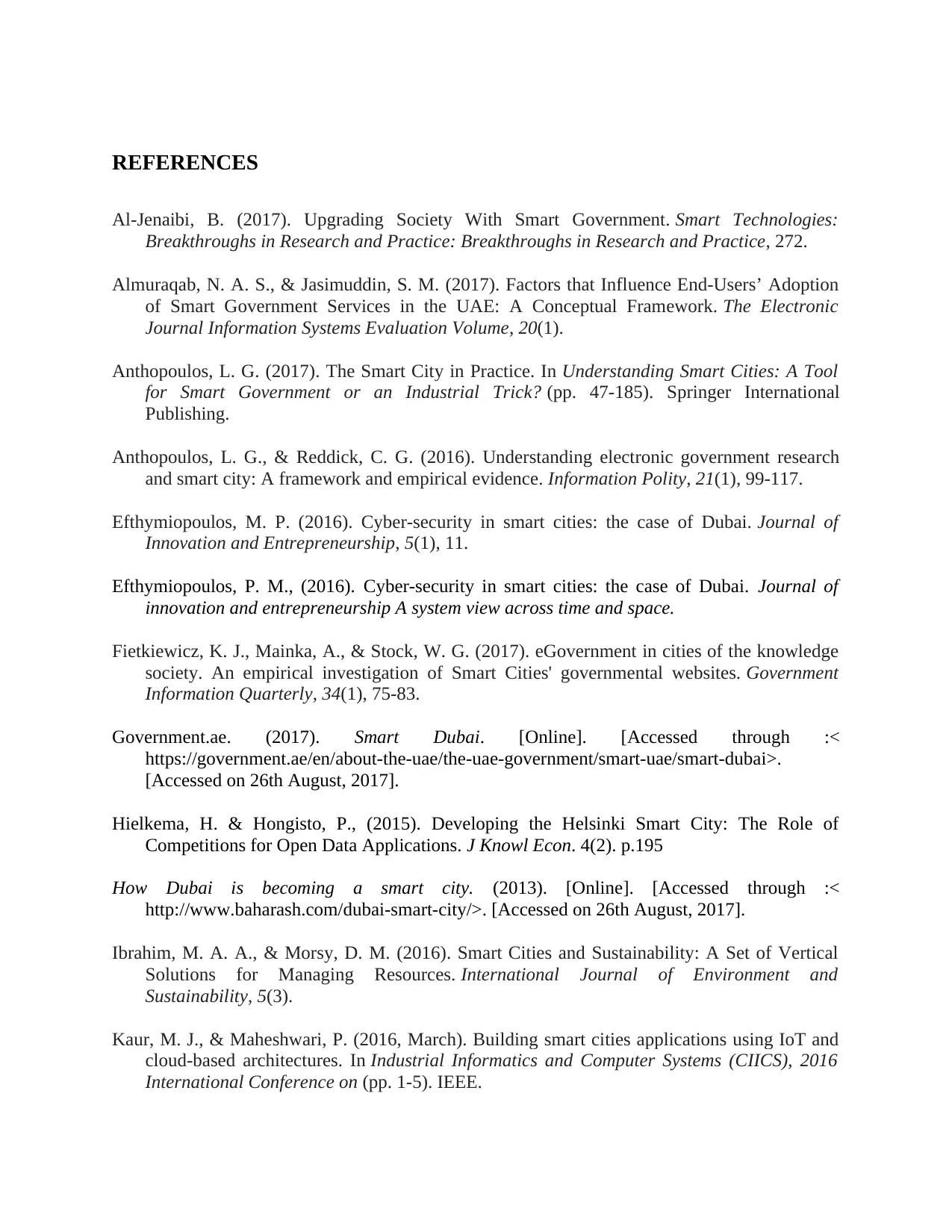
REFERENCES
Al-Jenaibi, B. (2017). Upgrading Society With Smart Government. Smart Technologies:
Breakthroughs in Research and Practice: Breakthroughs in Research and Practice, 272.
Almuraqab, N. A. S., & Jasimuddin, S. M. (2017). Factors that Influence End-Users’ Adoption
of Smart Government Services in the UAE: A Conceptual Framework. The Electronic
Journal Information Systems Evaluation Volume, 20(1).
Anthopoulos, L. G. (2017). The Smart City in Practice. In Understanding Smart Cities: A Tool
for Smart Government or an Industrial Trick? (pp. 47-185). Springer International
Publishing.
Anthopoulos, L. G., & Reddick, C. G. (2016). Understanding electronic government research
and smart city: A framework and empirical evidence. Information Polity, 21(1), 99-117.
Efthymiopoulos, M. P. (2016). Cyber-security in smart cities: the case of Dubai. Journal of
Innovation and Entrepreneurship, 5(1), 11.
Efthymiopoulos, P. M., (2016). Cyber-security in smart cities: the case of Dubai. Journal of
innovation and entrepreneurship A system view across time and space.
Fietkiewicz, K. J., Mainka, A., & Stock, W. G. (2017). eGovernment in cities of the knowledge
society. An empirical investigation of Smart Cities' governmental websites. Government
Information Quarterly, 34(1), 75-83.
Government.ae. (2017). Smart Dubai. [Online]. [Accessed through :<
https://government.ae/en/about-the-uae/the-uae-government/smart-uae/smart-dubai>.
[Accessed on 26th August, 2017].
Hielkema, H. & Hongisto, P., (2015). Developing the Helsinki Smart City: The Role of
Competitions for Open Data Applications. J Knowl Econ. 4(2). p.195
How Dubai is becoming a smart city. (2013). [Online]. [Accessed through :<
http://www.baharash.com/dubai-smart-city/>. [Accessed on 26th August, 2017].
Ibrahim, M. A. A., & Morsy, D. M. (2016). Smart Cities and Sustainability: A Set of Vertical
Solutions for Managing Resources. International Journal of Environment and
Sustainability, 5(3).
Kaur, M. J., & Maheshwari, P. (2016, March). Building smart cities applications using IoT and
cloud-based architectures. In Industrial Informatics and Computer Systems (CIICS), 2016
International Conference on (pp. 1-5). IEEE.
Al-Jenaibi, B. (2017). Upgrading Society With Smart Government. Smart Technologies:
Breakthroughs in Research and Practice: Breakthroughs in Research and Practice, 272.
Almuraqab, N. A. S., & Jasimuddin, S. M. (2017). Factors that Influence End-Users’ Adoption
of Smart Government Services in the UAE: A Conceptual Framework. The Electronic
Journal Information Systems Evaluation Volume, 20(1).
Anthopoulos, L. G. (2017). The Smart City in Practice. In Understanding Smart Cities: A Tool
for Smart Government or an Industrial Trick? (pp. 47-185). Springer International
Publishing.
Anthopoulos, L. G., & Reddick, C. G. (2016). Understanding electronic government research
and smart city: A framework and empirical evidence. Information Polity, 21(1), 99-117.
Efthymiopoulos, M. P. (2016). Cyber-security in smart cities: the case of Dubai. Journal of
Innovation and Entrepreneurship, 5(1), 11.
Efthymiopoulos, P. M., (2016). Cyber-security in smart cities: the case of Dubai. Journal of
innovation and entrepreneurship A system view across time and space.
Fietkiewicz, K. J., Mainka, A., & Stock, W. G. (2017). eGovernment in cities of the knowledge
society. An empirical investigation of Smart Cities' governmental websites. Government
Information Quarterly, 34(1), 75-83.
Government.ae. (2017). Smart Dubai. [Online]. [Accessed through :<
https://government.ae/en/about-the-uae/the-uae-government/smart-uae/smart-dubai>.
[Accessed on 26th August, 2017].
Hielkema, H. & Hongisto, P., (2015). Developing the Helsinki Smart City: The Role of
Competitions for Open Data Applications. J Knowl Econ. 4(2). p.195
How Dubai is becoming a smart city. (2013). [Online]. [Accessed through :<
http://www.baharash.com/dubai-smart-city/>. [Accessed on 26th August, 2017].
Ibrahim, M. A. A., & Morsy, D. M. (2016). Smart Cities and Sustainability: A Set of Vertical
Solutions for Managing Resources. International Journal of Environment and
Sustainability, 5(3).
Kaur, M. J., & Maheshwari, P. (2016, March). Building smart cities applications using IoT and
cloud-based architectures. In Industrial Informatics and Computer Systems (CIICS), 2016
International Conference on (pp. 1-5). IEEE.
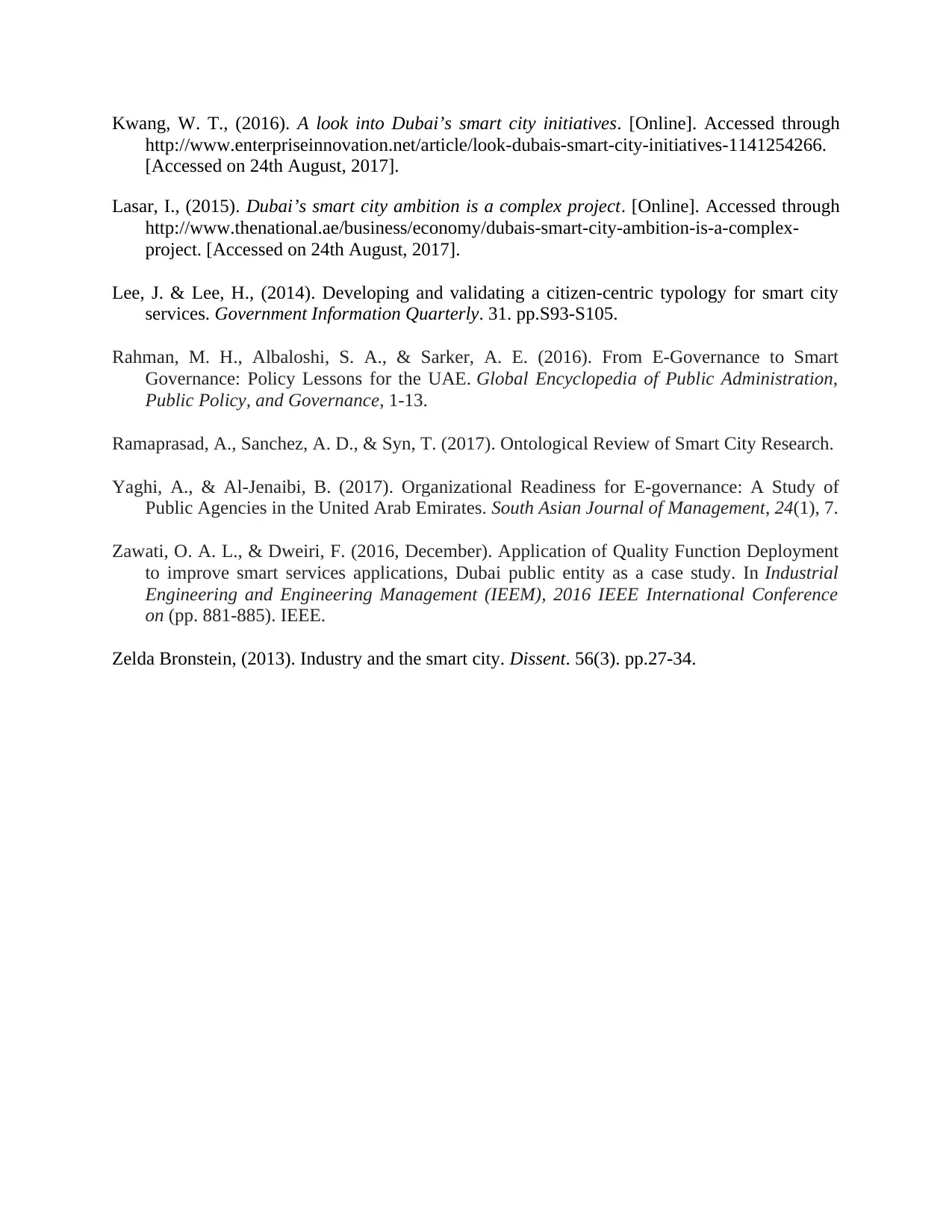
Kwang, W. T., (2016). A look into Dubai’s smart city initiatives. [Online]. Accessed through
http://www.enterpriseinnovation.net/article/look-dubais-smart-city-initiatives-1141254266.
[Accessed on 24th August, 2017].
Lasar, I., (2015). Dubai’s smart city ambition is a complex project. [Online]. Accessed through
http://www.thenational.ae/business/economy/dubais-smart-city-ambition-is-a-complex-
project. [Accessed on 24th August, 2017].
Lee, J. & Lee, H., (2014). Developing and validating a citizen-centric typology for smart city
services. Government Information Quarterly. 31. pp.S93-S105.
Rahman, M. H., Albaloshi, S. A., & Sarker, A. E. (2016). From E-Governance to Smart
Governance: Policy Lessons for the UAE. Global Encyclopedia of Public Administration,
Public Policy, and Governance, 1-13.
Ramaprasad, A., Sanchez, A. D., & Syn, T. (2017). Ontological Review of Smart City Research.
Yaghi, A., & Al-Jenaibi, B. (2017). Organizational Readiness for E-governance: A Study of
Public Agencies in the United Arab Emirates. South Asian Journal of Management, 24(1), 7.
Zawati, O. A. L., & Dweiri, F. (2016, December). Application of Quality Function Deployment
to improve smart services applications, Dubai public entity as a case study. In Industrial
Engineering and Engineering Management (IEEM), 2016 IEEE International Conference
on (pp. 881-885). IEEE.
Zelda Bronstein, (2013). Industry and the smart city. Dissent. 56(3). pp.27-34.
http://www.enterpriseinnovation.net/article/look-dubais-smart-city-initiatives-1141254266.
[Accessed on 24th August, 2017].
Lasar, I., (2015). Dubai’s smart city ambition is a complex project. [Online]. Accessed through
http://www.thenational.ae/business/economy/dubais-smart-city-ambition-is-a-complex-
project. [Accessed on 24th August, 2017].
Lee, J. & Lee, H., (2014). Developing and validating a citizen-centric typology for smart city
services. Government Information Quarterly. 31. pp.S93-S105.
Rahman, M. H., Albaloshi, S. A., & Sarker, A. E. (2016). From E-Governance to Smart
Governance: Policy Lessons for the UAE. Global Encyclopedia of Public Administration,
Public Policy, and Governance, 1-13.
Ramaprasad, A., Sanchez, A. D., & Syn, T. (2017). Ontological Review of Smart City Research.
Yaghi, A., & Al-Jenaibi, B. (2017). Organizational Readiness for E-governance: A Study of
Public Agencies in the United Arab Emirates. South Asian Journal of Management, 24(1), 7.
Zawati, O. A. L., & Dweiri, F. (2016, December). Application of Quality Function Deployment
to improve smart services applications, Dubai public entity as a case study. In Industrial
Engineering and Engineering Management (IEEM), 2016 IEEE International Conference
on (pp. 881-885). IEEE.
Zelda Bronstein, (2013). Industry and the smart city. Dissent. 56(3). pp.27-34.
⊘ This is a preview!⊘
Do you want full access?
Subscribe today to unlock all pages.

Trusted by 1+ million students worldwide
1 out of 9
Related Documents
Your All-in-One AI-Powered Toolkit for Academic Success.
+13062052269
info@desklib.com
Available 24*7 on WhatsApp / Email
![[object Object]](/_next/static/media/star-bottom.7253800d.svg)
Unlock your academic potential
Copyright © 2020–2025 A2Z Services. All Rights Reserved. Developed and managed by ZUCOL.





